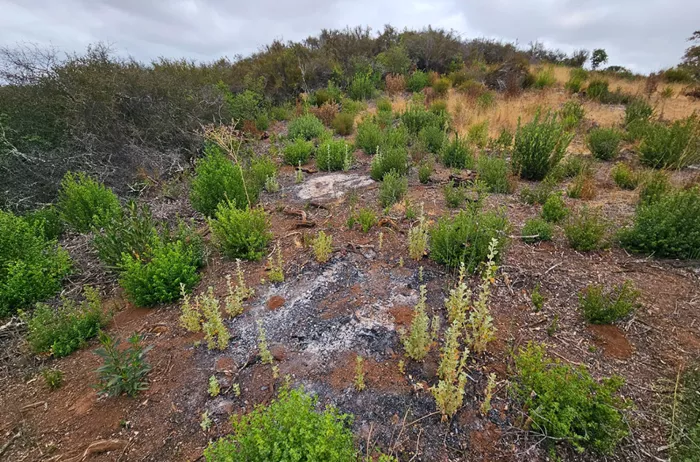The faculty director of Jasper Ridge Biological Preserve (‘Ootchamin ‘Ooyakma) reflects on a native plant thriving in an area treated with intentional burning earlier this year. It has been six months since the first controlled burns in the preserve’s 50-year history. In October 2023, nearly 200 piles of woody debris were created after clearing chaparral vegetation along the Westridge border. This effort was led by stewardship scientist Sheena Sidhu. In March 2024, a fire crew, under the direction of burn boss Phil Dye, conducted the burning of these piles.
This controlled burn was part of the university’s wildfire management plan. However, it also held deeper significance for the Muwekma Ohlone Tribe of the San Francisco Bay Area. On the first day of the week-long burn in March, Chairwoman Charlene Nijmeh and other Tribal members were present to guide the process. They shared their knowledge of the ecological importance of reintroducing sacred fire to their ancestral land. Tribal members offered blessings and prayers in the Chochenyo language, imbuing the event with a spiritual significance rooted in Indigenous wisdom, as noted in a Stanford Report article.
Now, six months later, some plants have returned to the burned area, especially along the edges of the piles. Here, we observe a surge of growth from fire-adapted chaparral plants, including yerba santa (Eriodictyon californicum), pitcher sage (Lepechinia calycina), and bluewitch nightshade (Solanum umbelliferum). Notably, we are also seeing an influx of rare plants that were not present before the fire. One significant find is the western bewildering bushmallow (Malacothamnus arcuatus var. arcuatus), which is endemic to the San Francisco Bay Area. This plant only grows on Ohlone land and is listed as “fairly threatened” by the California Rare Plant Ranks. A companion article by Adriana Hernandez offers further details about this plant and its history at the preserve.
Despite its threatened status, many new bushmallow plants are growing robustly around more than a dozen burned piles. These plants likely emerged from seeds that remained dormant in the soil for many years. Seeds of this plant can lie dormant for decades and require fire to germinate. A recent study found that 13 out of 15 seeds from an 88-year-old herbarium specimen successfully germinated (Morse 2023). In this preserve area, the seeds must have been dormant for over a century due to a long history of fire suppression. The growth of these plants only around the edges of the burned piles, rather than in the centers, indicates that the fire’s intensity was too strong in the middle, killing the seeds there. However, the fire’s intensity along the periphery was mild enough for the seeds to survive and sprout. This gentle fire reflects traditional Indigenous burning practices that promoted plant growth for centuries before European contact (Anderson and Keeley 2018). Although the specific uses of western bewildering bushmallow by local Indigenous peoples are not well-documented, its close relative, chaparral mallow (Malacothamnus fasciculatus), is used by the Kumeyaay in Southern California for various purposes, such as food, cordage, medicine, and hair rinses.
The resurgence of the endangered bushmallow symbolizes Indigenous awakening. Michael Wilcox, a senior lecturer in Native American studies, explains that “awakening” is a more appropriate term than “revitalization” when discussing the cultural and language resurgence of Indigenous groups.
In the Bay Area, the Ohlone peoples and their cultures have never disappeared, despite significant challenges over the years. Similarly, local native plants, like the western bewildering bushmallow, have survived despite severe declines due to fire suppression and environmental changes. When we restore Indigenous practices, like gentle burning, we revive the dormant seeds in the soil.
The bushmallow serves as a hopeful sign of what lies ahead as we re-establish the traditional relationship between humans and the local flora and fauna. With the Muwekma Ohlone Tribe actively seeking federal recognition through efforts like the Trail of Truth protest, a significant awakening of Native peoples and their science, culture, and languages seems inevitable. This awakening holds profound benefits not just for the tribe, but for all residents of the Bay Area. Indigenous wisdom is crucial for achieving environmental sustainability for everyone (Nelson and Shilling 2018).
The bushmallow at the burn site reminds us of the concept of “two-eyed seeing” (Bartlett et al. 2012), which emphasizes a multicultural approach to land stewardship. By integrating Indigenous and Western science in a spirit of mutual respect, Jasper Ridge Biological Preserve looks forward to promoting collaboration with Indigenous groups for research, education, and stewardship.
Related topics:
- Plants May Aid in Eliminating Nanoplastics from Our Environment
- New Seed Fossil Reveals Insights into How Plants Spread by Wind
- Create a New Flowerbed Now for a Beautiful Spring Garden


